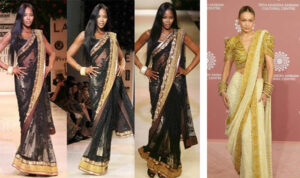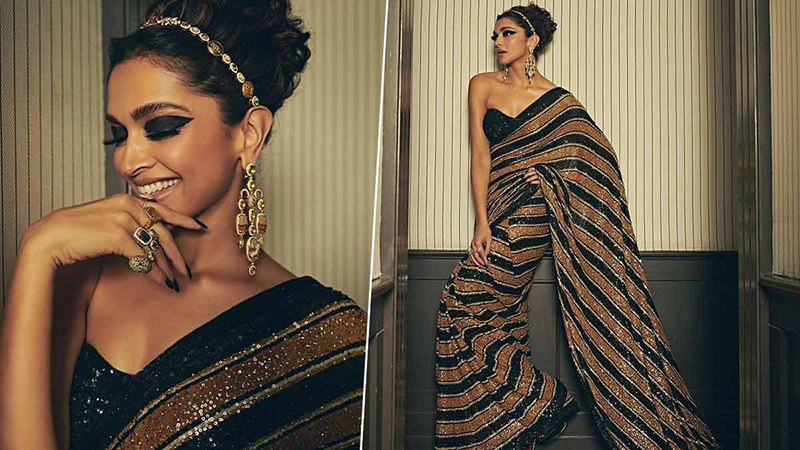On TikTok, the #sari hashtag has over 1.3 billion views and if this is not enough testament to the resurgence of this six-yard unstitched ensemble, it also recently created quite a splash at the Cannes Film Festival, bridging tradition and occasion-dressing. Taking a leap forward, an exhibition titled The Offbeat Sari was held in September at London’s Design Museum.
What has made the sari a global favourite today? One reason is because prominent personalities like Natasha Poonawala are making bold statements in it at New York’s Metropolitan Museum of Art. The wife of Adar Poonawala, the owner of the world’s largest vaccine company, shone in a gold sari embellished with a sculptural metal corset. Deepika Padukone, a jury member at the 75th Cannes Film Festival decided to ditch the gown and adopt the sari. Zendaya and Gigi Hadid donned saris at the Nita Mukesh Ambani Cultural Centre gala. Zendaya wore a star-studded one by couturier Rahul Mishra, and Gigi, a gold-crystal version by Abu Jani-Sandeep Khosla.
Designer Shruti Sancheti believes the sari is a traditional draped garment heralding Indian culture since time immemorial and each part of the country has a different draping tradition. “Currently, internationally the sari and its variants have found a way in collections of global luxury labels. They have time and again rolled out their renditions of the traditional drape starting from Zandra Rhodes to Hermes, McQueen, Dior and many more,” she says.

Their interpretation might be influenced by their culture and design philosophy but the core is the sari, and it has now been elevated to a global phenomenon. “India is a land of traditions and each state has a different weave and textile history along with draping techniques. However, with rapid urbanisation, increasing globalisation and digital and Bollywood presence, the quintessential sari has moved from its classic avatar to a contemporary, au courant one, and is favoured by the current generation who believe in global trends,” she adds.
Despite the influx of Westernisation, the soul is Indian, and as a designer she believes in the unsurpassed legacy of Indian textiles and weaves. “My experiments have been on just styling it in a contemporary manner by introducing shirt blouses to Obi belts. I have retained the undraped characteristic albeit in modern colour schemes, motifs and superior thread counts to make it fluid and versatile. The new-age woman is multitasking and looks for comfort along with oomph and style.”
“She prefers light-weight, sensuous options as the sari now is not an everyday wear, but occasion-wear and they prefer the pre-stitched, or easy to drape, or other comfortable, but glamorous trendy options which are not restrictive and heavy,” says Shruti.
The Offbeat Sari exhibition in London is a shining example to define the hybrid sari. It unravels the drape as a metaphor for the complex definitions of India today. “It exhibits examples of trailblazing saris from designers, wearers, and craftspeople in India. It is a beautiful attempt to showcase the contemporary sari,” says Shruti.
Saris are an integral part of her wardrobe and design philosophy, and she feels no woman can go wrong with the garment. Though there are many pre-stitched, draped variations, her tryst is always with the classics – the Banarasis, Bandhini and Maheshwari along with chiffons and lace.
Many global designers like Dior, Jean Paul Gaultier have paid respectful tribute to the sari which is not cultural appropriation but rather culture appreciation. For his fall-winter 2017-18-line, Jean Paul Gaultier “imagined a woman who travelled around the world and had lost track of the seasons—she could very well have found herself in Gstaad, wearing a sari. With global warming, seasons do not have the same meaning any more. It can be 20°C in winter and there can be snow in summer. The inspiration comes from the sari, but my reinventions are not literal. For instance, I have wool and cashmere versions (of the sari) in grey and black,” he said in an interview to Elle Magazine.
He looked at the sari with “awe and admiration. The drape, the colours and the fabrics… saris have made me dream since my first trip to India, when I was barely 20. Indian women look royal in saris: it lends them greater beauty. As an outfit, it is extremely generous; it blends well with all shapes”.
The slow but sure impact of the sari can be seen over the years when in 2016, Indian model Dipti Sharma stole the thunder at the Dolce and Gabbana show in Italy with a custom-made saree. Stefano Gabbana of Dolce & Gabbana, admits he was culturally inspired by Dipti. “We have a model, an Indian girl, and we told her: ‘We’ll give you a piece of fabric and you do, by yourself, the sari and after that, we’ll customise the outfit. We love the tradition. In this case, we love to put our touch on the Indian tradition,” said Gabbana.
Lebanese guru of couture Elie Saab’s line Enter India, was an homage to ‘Incredible India’ with a sea of glittering saris and lehengas. “India is her backdrop and inspiration for a new blend of formalism and ease, opulence and elementary lines,” Saab had said in his press docket.
Preeti Jain of the label Nirmooha says the sari’s evolution into a global phenomenon can be attributed to its timeless elegance and adaptability. Its versatility in being both traditional and trendy has captured the attention of people around the world.
While the sari has undergone changes to match modern preferences, it has not entirely lost its traditional essence. Designers have found ways to strike a balance between preserving its heritage and incorporating contemporary elements.

“We have introduced several modern versions of the sari that prioritise comfort and convenience. These include pre-stitched saris, fusion styles with pants, and innovative draping techniques. Modern women view the sari as a symbol of empowerment and grace. Given their fast-paced lives, they seek lightweight fabrics and minimalistic textures that allow for easy movement,” says Jain.
The sari’s popularity among celebrities showcases its cross-cultural appeal and adaptability. Their confident embrace of the sari has contributed to its global recognition. “My personal experience with the sari has been deeply enriching. It is a testament to the seamless blend of tradition and modernity, which resonates with diverse audiences. Much like Balenciaga, Ferre and Gres, designers today engage with the sari’s heritage in innovative ways. They reinterpret draping techniques while paying homage to its origins, fostering a continuous evolution in design,” adds Jain.
Anju Modi remembers the time when Alexander McQueen played with the Kanjeevaram weave in 2008, using its borders ingeniously. Some designers created a dress with the drape, and this year has been the tipping point. The drape has been part of the cultural tapestry of the country with Ajanta and Ellora bearing testament to this fact.
“The sari is fluid so there is so much you can do with it; celebs have expressed their undying love. I have teamed a trench coat with a sari, or coats and even a play with pallus. The saris accentuate the waistline, curvaceous, and have an intrinsic value, exuding intelligent beauty,” says Anju. Young women do not know how to tie pleats and they desire ease, thus there are variations of the saris she has created with zippers and pants, though the designer for the Swadeshi collection offered angrakha with saris and some came with draped lungis. – The writer is a senior fashion journalist based in Delhi.


Leave a Reply